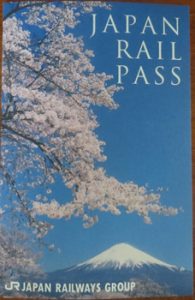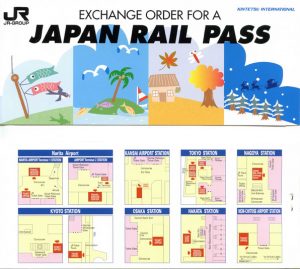Japan Rail Pass
NOTE: Since the cost of the Japan Rail Pass went up by 60-70% in October 2023 the prices quoted in the 5th edition of Japan by Rail are no longer correct. Look at japanbyrail.com/updates-and-news for the current details though the paragraph below has been amended here but not the prices. The current prices are shown on the Updates and news page.
Until October 2023 the Japan Rail Pass was truly the bargain of the century, assuming you planned to use several shinkansen (bullet train) services. However, it is now no longer cost effective though it does still entitle the pass-holder to travel freely on: almost all JR services including shinkansen, other than the Nozomi (Tokyo to Hakata) and Mizuho (Hakata to Kagoshima-chuo), though it is now possible to travel on these for an additional charge; the ferry service to Miyajima (see p309) operated by JR; and some of JR’s bus services, though not their highway bus services, as well as their sightseeing bus services in certain places, such as Kyoto, Kanazawa and Hiroshima.

Who can use the Japan Rail Pass?
Japan Rail Pass prices
The prices in brackets are for rough guidance only and are based on the exchange rates quoted in the 5th edition of Japan by Rail. The exact cost will depend on the exchange rate used by your rail pass agent at the time of purchase.
Bought from an agent outside Japan
Ordinary Class Green Class
7-day ¥29,650 (£195/$256) ¥39,600 (£261/$342)
14-day ¥47,250 (£311/$408) ¥64,120 (£423/$554)
21-day ¥60,450 (£398/$522) ¥83,390 (£550/$721)
Bought in Japan, or through the JR website before you go
Ordinary Class Green Class
7-day ¥33,610 (£221/$290) ¥44,810 (£295/$37)
14-day ¥52,960 (£349/$458) ¥72,310 (£577/$625)
21-day ¥66,200 (£436/$572) ¥91,670 (£604/$793)
Notes: Prices are fixed in yen, but the charge is payable in local currency. The prices in brackets are for guidance only. The dollar ($) rates are US dollars.
Children aged 5 and under travel free providing they do not occupy a seat; those aged 6-11 pay half the adult rate. The adult rate applies to everyone aged 12 and over.
Buying a Japan Rail Pass
The cheapest way to get a pass (sold in the form of an exchange voucher; see p39 in Japan by Rail for details) is to buy one through an authorised agent no earlier than three months before you plan to go.

A more expensive option is to buy one when you arrive in Japan. However, for the same price (see below), it is now possible to order a pass through a JR website from a calendar month before you plan to use it Japan. These options are convenient if you don’t have a rail pass agent in your home country or if you are travelling anyhow. The only other advantage of this new style pass is that you can make seat reservations online before you go to Japan (as long as you have ordered a pass). However this isn’t really necessary unless you are travelling in peak periods. For further information see the box on p39 in Japan by Rail.
However you get a pass you can buy as many as you want, but only up to six at a time for the online option.
Class of travel The next step is to choose which class you’d like to travel in. The Ordinary Pass is valid for standard-class rail travel, which is likely to be more than adequate for most people. Seats in Ordinary Class are comfortable and have ample legroom; on some trains they are as good as first-class rail travel elsewhere in the world. The Green Pass is for those wishing to travel in more style. Green-class carriages (known as ‘Green Cars’) offer seats that are wider, recline more, and have even more legroom as well as a foot rest; there is also more luggage space. However, there are no Green Cars on most services on the Sanyo shinkansen line (Shin-Osaka to Hakata), or on Tsubame shinkansen (Hakata to Kagoshima-chuo) in Kyushu. Most limited express (LEX) services have Green Cars but local/rapid trains generally only have Ordinary Class.
Is it worth buying a Japan Rail Pass?
As stated above we believe the Japan Rail Pass is a fantastic bargain and that it is almost always worth having for a trip to Japan.
However, for some itineraries this may not be the case. We analysed LR’s 13-day itinerary (see Itineraries) and found that the total cost of the travel with seat reservations in most cases and using:
- JR limited express (LEX) trains and private lines where essential would have been about ¥21,000;
- JR shinkansen and LEX trains where possible and private lines where essential would have been about ¥35,500
- JR rapid/local trains with the occasional LEX and private lines where essential would have been about ¥19,500
- private lines where possible and JR where that was the only option would have been about ¥21,000.
To cover the whole period it would have been necessary to buy a 14-day Japan Rail Pass – since a 14-day Ordinary Class pass now costs at least ¥47,250 it clearly would have been a waste of money. Even buying a 7-day pass for part of this trip would not have been worth it at any stage.
The main reasons for this conclusion are that this trip
- didn’t involve any long-distance shinkansen journeys. Even though the quickest way to get between Kyoto, Osaka and Kobe is by shinkansen both JR and private companies operates a range of services between these cities and since they are reasonably close together it doesn’t take long to travel between them.
- included a trip to Koya-san where access is only possible on a private line (Nankai) and the best value is getting the World Heritage Ticket. This situation would also apply to an itinerary including Hakone as the Hakone Free Pass is undoubtedly the best way to see that area.
- included several days sightseeing in Tokyo and Kyoto as well as a couple of nights in Tsumago which can only be reached by bus, or on foot.
In summary: as we say in Japan by Rail, if you plan to take a return trip on the shinkansen between Tokyo and Kyoto even with a 7-day pass you will almost always save money as you will definitely need to get to and from the airport and are likely to have at least one other journey on a JR service.
If you do not plan any long-distance shinkansen journeys it may be worth considering other options – one of the regional JR passes could prove better in your circumstances. Or, it may be better to buy tickets as you go – this doesn’t need to be time consuming as if you have planned your itinerary you could buy most of your tickets when you first arrive rather than whenever you need to travel. Also, if you get an IC card (such as a Suica, Pasmo, or other such card; see p66 in Japan by Rail) and keep it topped up you can use that for most journeys on ordinary trains, whether JR or private.
